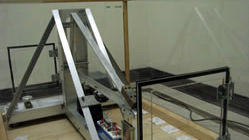The department maintains two seismographs for recording vertical and horizontal ground movement.
What is an earthquake?
An earthquake is a sudden release of energy from the earth's crust that results in the distribution of seismic waves all throughout the world.
The scientific theory of plate tectonics, coined in the early 1900's by Alfred Wegener, proposed that large sections of crust continuously move and collide with one another. Once two plates collide they begin to build up stress until they can withstand no more. Fractures and faults begin to form causing land deformation and inevitably seismic disturbances.
It is these seismic waves that produce the ground-shaking that we witness first-hand when an earthquake occurs.
Measuring an earthquake
Scientists have been able to analyze the wave signals emanating from an earthquake by using a machine called a seismograph. These machines have the capability to identify seismic signals from all over the world. The way this process works is actually rather simple.
Let us say that an earthquake occurs 66 miles away from Calvin University. A tectonic shift, for example, initiates a series of seismic vibrations that travel through the mantle and the earth's crust. A seismograph, in its simplest form, is built with a free-hanging needle that moves like a pendulum over a seismogram. When the ground begins to move, the needle remains stationary as the seismogram below it moves back and forth with the motion of the earth during the earthquake. The pendulum, which has a pen attached to its tip, records the vibrations on the seismogram.
Seismologists interpret this data to identify the frequency and magnitude of the earthquake. In 1935, Charles Richter developed a logarithmic scale that denotes a calibrated number to a specific intensity of an earthquake. This scale, with intensities ranging from 0.1 to 10, categorically separate earthquakes by energy released and the damage that follows. Earth tremors that are recorded below 2.0 on the Richter Scale are considered micro-quakes and are rarely felt. A quake with a magnitude of 10, on the other hand, is epic and immense damage will occur. To put things into perspective, in 1906 San Francisco, California experienced a magnitude 7.9 earthquake which caused gas lines to rupture and thousands of houses and buildings to collapse. The resulting damage from the earthquake then started a giant conflagration that left approximately 250,000 homeless. Increased education and public awareness of earthquakes, as with many other natural disasters, can play a significant role in reducing the number of lives lost in an earthquake.
In the 1970's, the Richter magnitude scale was succeeded by the moment magnitude scale (MMS), which similarly measures the size of earthquakes in terms of the energy it releases. The magnitude that is recorded is based on the moment of the earthquake, which is equal to the rigidity of the Earth multiplied by the average amount of slip seen along the fault. Even though the two scales calculate data differently, the MMS still retains the familiar magnitude values defined by the older Richter magnitude scale. MMS is currently the official scale used by the United States Geological Survey (USGS) to estimate magnitudes of earthquakes all around the world.
Calvin's own seismograph
Located in the basement of North Hall (NH 065) resides our very own seismograph. This machine is set up in a way that it is continually recording and displaying long-wave and short-wave seismic signals generated from all over the world. The seismograph has been up and running for the past 10 years and is recording and archiving every seismic signal it picks up. The seismic graph at the top of this page is and example of the aforementioned data.
Human awareness
As scientists continually gather and analyze worldwide earthquake data they become increasingly able to implement this data to minimize the negative human impact of earthquakes. The most powerful tool anyone can have when an earthquake strikes is advocacy and knowledge. Here are some essential tools to remember if and when an earthquake occurs: (1) first and most importantly, STAY CALM, make sure to think through every action you take; (2) If you are inside, stay inside. If you are outdoors, stay outdoors. The shorter the amount of time you take to get to a safety spot means less time you're vulnerable to be hit by flying debris; (2a) If indoors, take refuge under heavy furniture or a supported doorway away from any windows or glass; (2b) if outdoors, move yourself away from any buildings, utility lines, or trees. The greatest danger comes from flying or falling debris; (3) If you are in a moving car, pull over to the side of the road and out of the way of traffic, but stay inside the car. The suspension in the vehicle will take most of the impact of the quakes; (4) Last but not least, make sure to extinguish any and all fires. Earthquakes can rupture gas lines, so even if the earthquake knocks out the power you should refrain from lighting candles.
A geological aside
Earthquakes, although very frightening, are still an essential part of the world in which we reside. The Earth is an ever-renewing sphere of splendor. It has the incredible capability of creating and sustaining life, but it also holds in its grasp the power to destroy it just as easily. Understanding that we live in this morphing world may make some people feel a bit uneasy, but one can find solace in knowing that these processes, in many ways, are beneficial to all life on this planet, not just humanity. The subduction of denser oceanic plates under a continent may inevitably cause an earthquake, but without this subduction, we would not see any of the wondrous mountain ranges that are focal vacation spots around the world; or the ever-shifting plates that constructed the volcanic range in Hawaii. These magnificant localities are the result of an earth that is changing just as humans are, just much, much more slowly.







